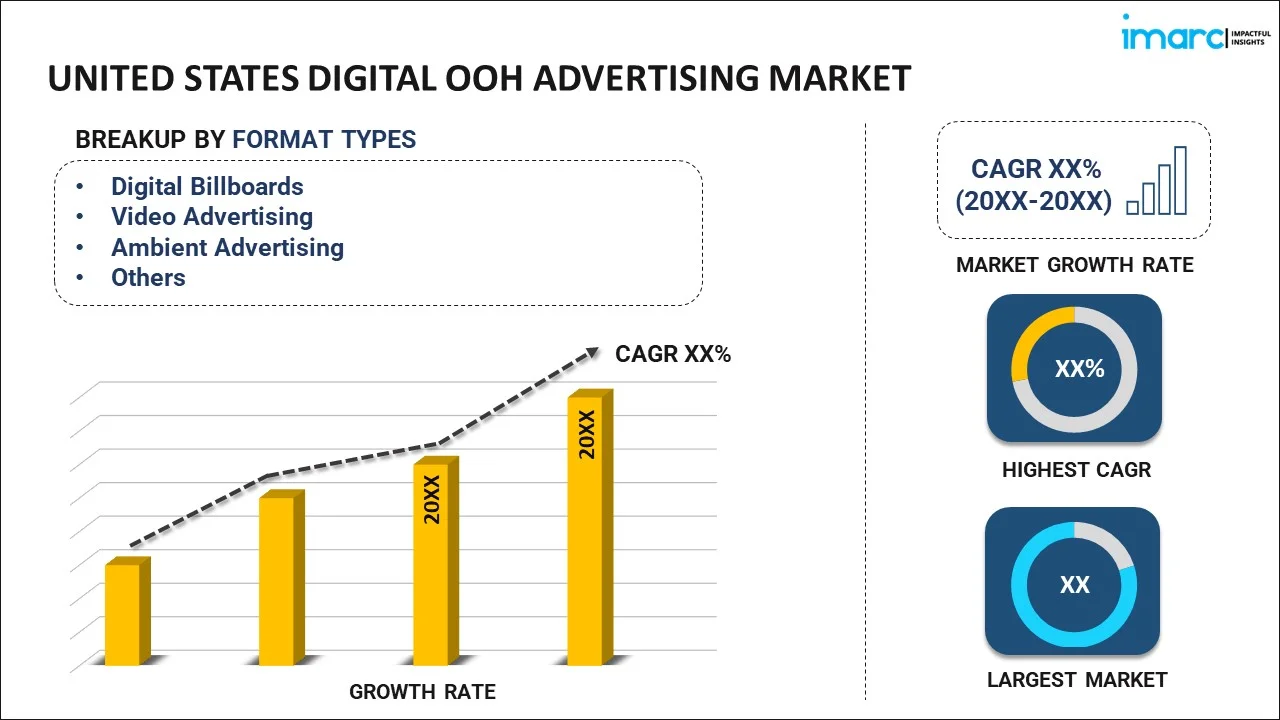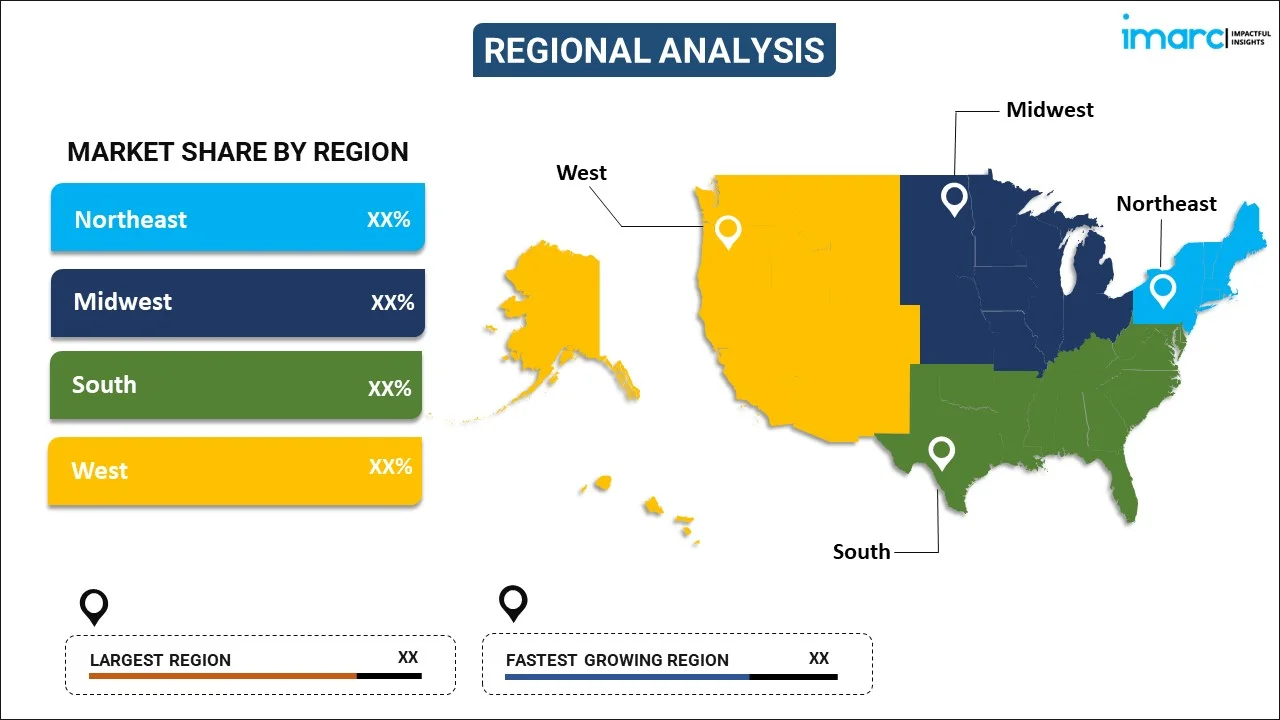
United States Digital OOH Advertising Market Report by Format Type (Digital Billboards, Video Advertising, Ambient Advertising, and Others), Application (Outdoor, Indoor), End Use Industry (Retail, Recreation, Banking, Transportation, Education, and Others), and Region 2025-2033
Market Overview:
The United States digital OOH advertising market size reached USD 6.1 Billion in 2024. Looking forward, IMARC Group expects the market to reach USD 14.7 Billion by 2033, exhibiting a growth rate (CAGR) of 9.79% during 2025-2033. The market is fueled by progress in programmatic tech, enhanced audience measurement solutions, and the overlap of retail media with digital signage. These tech innovations allow advertisers to deliver contextually targeted, real-time messages in various public places, boosting engagement and campaign results. As DOOH advertising becomes more aligned with omnichannel tactics, adoption is growing steadily. Further growth is anticipated as marketers continue to focus on flexibility, data insights, and high-impact consumer touchpoints in dense locations.
United States Digital OOH Advertising Market Insights:
- Retailers implement digital signage to enhance in-store activity and promotions.
- Programmatic advertising facilitates live targeting and campaign optimization flexibility.
- Sophisticated audience analytics enhance measurement, attribution, and campaign accountability.
- Miniaturized LED technology produces higher display quality and energy efficiency.
- Digital screens become popular throughout malls, airports, and transit areas.
|
Report Attribute
|
Key Statistics
|
|---|---|
|
Base Year
|
2024
|
|
Forecast Years
|
2025-2033
|
|
Historical Years
|
2019-2024
|
|
Market Size in 2024
|
USD 6.1 Billion |
|
Market Forecast in 2033
|
USD 14.7 Billion |
| Market Growth Rate (2025-2033) | 9.79% |
Digital OOH (out-of-home) advertising includes digital billboards, small digital signs, outdoor signage and display screens, which are accessible to the public. It is generally installed at airports, railway stations, bus shelters, medical waiting rooms, shopping malls, retail stores, movie theatres and roadways to advertise goods and services. At present, advertisers in the United States are using virtual screens, projectors, motion graphics and video content to target specific demographics.
Technological advancements, along with the presence of numerous shopping complexes and malls, represent one of the key factors spurring the market growth in the United States. Apart from this, digital display expansion, increasing media fragmentation, improving audience measurement, and rising traffic congestion and travel time are some of the other major factors contributing to the market growth. Furthermore, technological advancements in display technologies, such as miniaturization and rollout of micro light-emitting diodes (LEDs), are escalating the demand for digital OOH advertising in the country. However, as the US Government has announced lockdown, it is encouraging the adoption of social distancing measures to minimize the transmission of the coronavirus disease (COVID-19). This led to the temporary closure of public places and transportation facilities, such as airports, buses, railway stations, shopping malls and movie theatres, which, in turn, negatively impacted the market growth.
United States Digital OOH Advertising Market Trends:
Programmatic Integration Increasing Flexibility for Campaigns
The growth of programmatic technology is significantly transforming out-of-home (OOH) advertising in the United States. Advertisers can now automate the buying and placement of commercials on digital screens based on real-time data and audience information. This allows brands to make more targeted and contextually relevant messages based on variables such as location, time of day, traffic patterns, or weather conditions. As opposed to old-fashioned static billboards, programmatic DOOH enables dynamic content updates and greater operational efficiency. Campaigns may now be instantly activated or stopped, based on performance indicators or strategic requirements. Additionally, this technology brings DOOH into line with the wider digital advertising environment, facilitating brands' ability to include it in omnichannel strategies. As demand for measurable, flexible, and data-driven marketing increases, the programmatic shift of DOOH advertising is likely to continue to gather momentum, drawing in both national brands and local retailers seeking precision and effectiveness.
Retail Media Convergence Fuelling Contextual Placements
U.S. retail settings are becoming more significant locations for digital out-of-home (DOOH) advertising as retailers and brands embrace the value of reaching consumers at or near the point of purchase. Digital screens in stores, malls, and grocery chains are increasingly serving ads that are specific to the in-store context, promoting product discovery and encouraging impulse buys. This is part of a broader trend toward a convergence between retail media networks and digital signage, where physical spaces of commerce become advertisement platforms. The retailers get to monetize screen space, while brands get to leverage direct proximity to shoppers in applicable contexts. Further, improvements in shopper analytics and location-targeting allow brands to deliver tailored content, enhancing campaign relevance and engagement. Since customers anticipate frictionless brand interactions across physical and digital touchpoints, such integration is also effective for shaping purchasing decisions. As per the reports, in April 2025, Walmart announced a 50% YoY increase in worldwide ad revenue, supported by Walmart Connect and Vizio integration, strengthening profitability in the face of inflation and tariffs through expanded retail media. Moreover, DOOH advertising based on retail is set to grow as more advanced display infrastructure and analytics are implemented in retailing.
Improvements in Audience Measurement and Attribution
Enhanced audience measurement and attribution features are driving the strategic relevance of digital out-of-home (DOOH) advertising in the United States. Traditionally, the DOOH industry had failed to provide the performance metrics typical to digital marketing media, which put it off for data-driven buyers. However, recent advancements , such as mobile tracking, computer vision, and anonymized location analytics are enabling advertisers to more effectively determine who their audiences are encountering and what they are doing in response. These technologies enable the measurement of metrics such as dwell time, exposure frequency, and post-view actions like store visits or app usage. Crucially, this data-led approach is rising accountability, enabling advertisers to make return on investment assessments more precisely. It also facilitates real-time campaign optimization, allowing for the ability to make changes based on performance learnings. With an increasingly large number of advertisers demanding cross-channel consistency and quantifiable results, DOOH's capability of producing transparent, actionable data is making it a more central part of overall media plans.
Key Market Segmentation:
IMARC Group provides an analysis of the key trends in each segment of the United States digital OOH advertising market report, along with forecasts at the regional and country level from 2025-2033. Our report has categorized the market based on format type, application, and end use industry.
Breakup by Format Type:

To get more information on this market, Request Sample
- Digital Billboards
- Video Advertising
- Ambient Advertising
- Others
Breakup by Application:
- Outdoor
- Indoor
Breakup by End Use Industry:
- Retail
- Recreation
- Banking
- Transportation
- Education
- Others
Breakup by Region:

- Northeast
- Midwest
- South
- West
Competitive Landscape:
The competitive landscape of the industry has also been examined along with the profiles of the key players.
Latest News & Developments:
- In November 2024, Miami-based Lumix Advertising announced plans to launch scooter-mounted LED billboard boxes in December. Each of the 24 delivery scooters will feature digital screens cycling through ads. The innovation targets small businesses with affordable exposure and adds to Miami’s evolving digital out-of-home advertising environment, blending mobility with visibility.
- In August 2024, KEVANI announced Bricklights, a double-sided digital billboard on Interstate 5 in Norwalk, launching in Q1 2025. Positioned for maximum visibility, it targets over two million monthly impressions, strengthening KEVANI’s footprint in the U.S. digital out-of-home advertising landscape with high-resolution, 24/7 brand exposure for commuters.
- In January 2025, T-Mobile made an acquisition of Vistar Media for \\$600 million to deepen its Digital Out-of-Home (DOOH) advertising capabilities. The acquisition pairs T-Mobile's consumer insights with Vistar's ad tech to improve campaign targeting, efficiency, and scale on a worldwide network of digital advertising screens.
Report Coverage:
| Report Features | Details |
|---|---|
| Base Year of the Analysis | 2024 |
| Historical Period | 2019-2024 |
| Forecast Period | 2025-2033 |
| Units | Billion USD |
| Segment Coverage | Format Type, Application, End Use Industry, Region |
| Region Covered | Northeast, Midwest, South, West |
| Customization Scope | 10% Free Customization |
| Post-Sale Analyst Support | 10-12 Weeks |
| Delivery Format | PDF and Excel through Email (We can also provide the editable version of the report in PPT/Word format on special request) |
Key Questions Answered in This Report
Digital Out-of-Home (DOOH) advertising refers to dynamic digital media displayed in public spaces through digital billboards, screens, and signage. It includes content shown at airports, malls, transit stations, and roadways, enabling advertisers to deliver targeted messages using video, motion graphics, and real-time data for improved audience engagement and contextual relevance.
The United States digital OOH advertising market market was valued at USD 6.1 Billion in 2024.
The United States digital OOH advertising market market is projected to exhibit a CAGR of 9.79 during 2025-2033, reaching a value of USD 14.7 Billion by 2033.
The United States digital OOH advertising market is driven by technological advancements, expanding retail infrastructure, growing programmatic capabilities, improved audience analytics, and increasing demand for contextual, location-based advertising. These factors enable advertisers to optimize campaign reach, deliver dynamic content, and integrate DOOH into broader omnichannel strategies, supporting steady market growth.
Need more help?
- Speak to our experienced analysts for insights on the current market scenarios.
- Include additional segments and countries to customize the report as per your requirement.
- Gain an unparalleled competitive advantage in your domain by understanding how to utilize the report and positively impacting your operations and revenue.
- For further assistance, please connect with our analysts.
 Request Customization
Request Customization
 Speak to an Analyst
Speak to an Analyst
 Request Brochure
Request Brochure
 Inquire Before Buying
Inquire Before Buying




.webp)




.webp)












